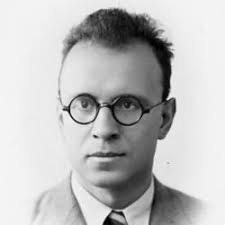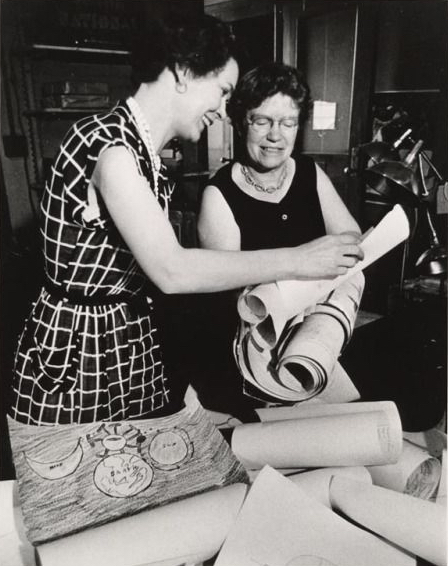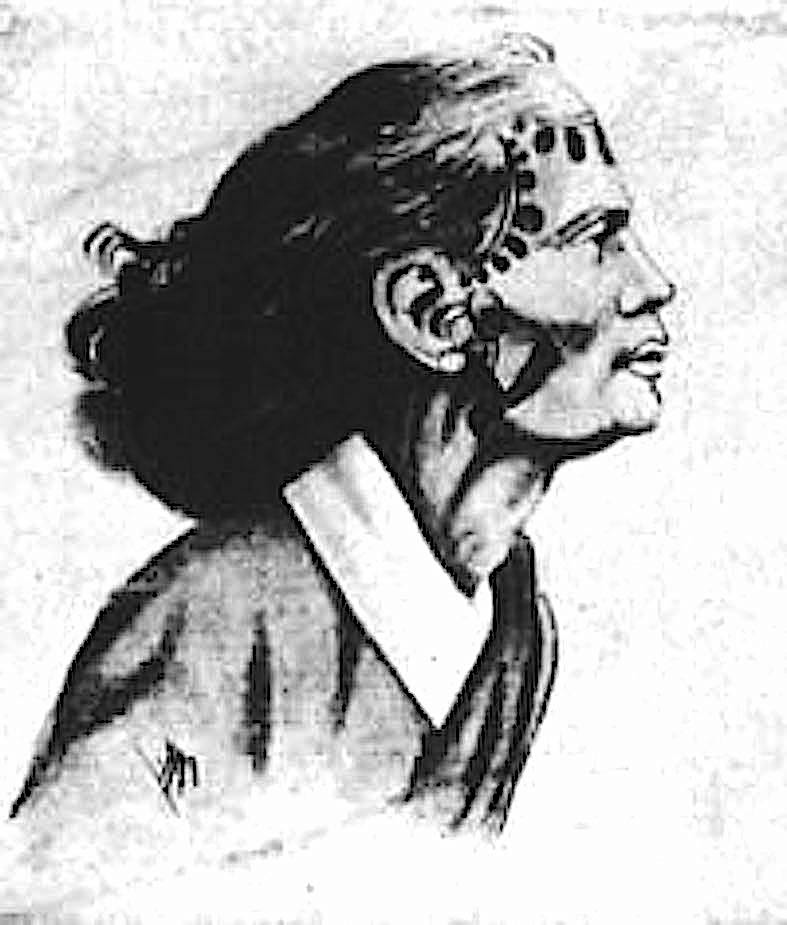

アルフレッド・メトロー
Alfred Métraux,
1902-1963; Rhoda Métraux, 1914-2003


☆アルフレッド・メトロー(フランス語発音:[alfʁɛd metʁo]、1902年11月5日 - 1963年4月12日)は、スイスおよびアルゼンチンの人類学者、民族学者、人権活動家だった。
★ローダ・ブベンディ・メトロー(1914年10月18日、ニューヨーク市 - 2003年11月26日、バーモント州バートン)は、異文化研究の分野で著名な人類学者である。アルフレッド・メトローと共同でハイチのヴードゥー教を研 究した。また、パプアニューギニアのセピック川中流域のイアトムル人民を研究し、1967年から1968年、1971年、1972年から1973年の3 回、タンブヌム村にそれぞれ6~7ヶ月間、音楽に焦点を当てたフィールドワークに出かけた[1]。メトローはその研究のひとつで、マーガレット・ローエン フェルドが開発したローエンフェルド・モザイクテストをタンブヌムで実施した。さらにメトローはメキシコ、アルゼンチン、西インド諸島のモンセラットで フィールドワークを行い、エール大学に入学してブロニスワフ・マリノフスキーの指導のもと博士号取得のための研究を行った[2]。第二次世界大戦中、メト ローはアメリカの戦略サービス局(OSS)でドイツの士気に関するセクションの責任者を務めた。
| Alfred
Métraux (French pronunciation: [alfʁɛd metʁo]; 5 November 1902 – 12
April 1963) was a Swiss and Argentine anthropologist, ethnologist and
human rights leader. |
アルフレッド・メトロー(フランス語発音:[alfʁɛd metʁo]、1902年11月5日 - 1963年4月12日)は、スイスおよびアルゼンチンの人類学者、民族学者、人権活動家だった。 |
| Early life Born in Lausanne, Switzerland, Métraux spent much of his childhood in Argentina where his father was a well-known surgeon resident in Mendoza. His mother was a Georgian from Tbilisi. He received his secondary and university education in Europe, at the Classical Gymnasium of Lausanne, the École nationale des chartes in Paris, the École nationale des langues Orientales (Diplome, 1925). The École pratique des hautes études (Diplôme, 1927) and the Sorbonne (Docteur ès lettres, 1928). He also studied in Sweden, in Gothenburg's University and did research at the well-equipped local anthropological museum. Among his teachers were Marcel Mauss, Paul Rivet, and Erland Nordenskiöld. While he was still a student he entered into correspondence with Father John Cooper who introduced him to the American school of cultural anthropology. It is said that Father Cooper did not realize at first that his scholarly correspondent was only 19 and 20 years old. They actually met much later, when Métraux came to the United States; but Father Cooper seems to have had considerable influence on Alfred Métraux's thought. Métraux combined in his work the best of both the European and the American tradition of historical anthropology. |
生い立ち スイスのローザンヌで生まれたメトローは、幼少期の大半をアルゼンチンで過ごした。父親はメンドーサに住む有名な外科医だった。母親はトビリシ出身のグル ジア人だった。中等教育と大学教育はヨーロッパで受け、ローザンヌの古典ギムナジウム、パリの国立カルテ学院、国立東洋言語学院で学んだ(1925年、 ディプロム取得)。パリ高等師範学校(Diplôme、1927年)、ソルボンヌ大学(Docteur ès lettres、1928年)で学ぶ。スウェーデンのヨーテボリ大学でも学び、設備の整った地元の人類学博物館で研究を行った。 師事したのはマルセル・モース、ポール・リヴェット、エルランド・ノルデンスキオールドらである。在学中にジョン・クーパー神父と文通を始め、彼にアメリ カの文化人類学を紹介した。クーパー神父は最初、彼の学究的な文通相手がまだ19歳と20歳であることに気づかなかったと言われている。しかし、クーパー 神父はアルフレッド・メトローの思想に大きな影響を与えたようである。メトローは、ヨーロッパとアメリカの歴史人類学の伝統の両方の長所を自分の仕事に取 り入れた。 |
| Early career Métraux's professional career was equally cosmopolitan. His interest for anthropology and original languages, began early in his life when his father a medical doctor took an overseas appointment, relocating his family from Lausanne Switzerland to Mendoza Argentina. During his research years in Argentina, his work was centred in the study and interpretation of native languages, allowing him to create an extensive record of Argentine native ethnic groups, including: Calchaquí, Guaraní, Chiriguano, Toba & Wichís, and the Uros-Chipaya. While working on this research, he was invited to collaborate in the writing of the Handbook of South American Indians. Eventually, he founded and became the first director (1928 – 1934) of the Institute of Ethnology at the University of Tucuman, in Argentina. During this period, he also published an article for the Universidad Nacional De la Plata Museo of Argentina called "Mitos y cuentos de los Indios Chiriguano" Myths and Stories of the Chiriguano Indians.  Ana Eva Hei by Walter Knoche, 1911 In 1934–35, he led a French expedition to Easter Island, publishing an ethnology of the indigenous people of the island.[1] This included a description of one the last women to receive traditional facial tattoos, Ana Eva Hei.[2] In 1936 –38, he was a Fellow of the Bishop Museum in Honolulu. In 1939, he returned to Argentina and Bolivia for field research on a Guggenheim Fellowship. In 1940, upon his return to the United States from South America, he was in residence at Yale University with a renewal of his Guggenheim Fellowship. That next year, he worked with the Cross Cultural Survey (now the Human Relations Area Files) on South American data and was associated with such people as John Dollard, Leonard Bloomfield, and others of the Institute of Human Relations. In 1941, he joined the staff of the Bureau of American Ethnology of the Smithsonian Institution. There, from 1941 to 1945, he played an important role in producing the monumental Handbook of South American Indians. Perhaps no other writer contributed as many pages to this work. As the editor, Julian Steward, acknowledges, "The extent of his (Métraux's) contribution is by no means indicated by the large number of articles appearing under his name. With an unsurpassed knowledge of South American ethnology and ever generous of his time, his advice and help to the editor and contributors alike have been a major factor in the successful completion of the work." (Vol. I, p. 9). In addition, Métraux taught briefly at University of California, Berkeley (1938), the Escuela Nacional de Antropología, Mexico (1943), the Colegio de Mexico (1943), and the Faculdad Latino-Americana de Ciencias Sociales, Santiago, Chile (1959–60). |
初期のキャリア メトローの専門家としてのキャリアも同様に国際的なものだった。彼の人類学と原語への興味は、医学博士であった父が海外赴任を命じられ、一家をスイスの ローザンヌからアルゼンチンのメンドーサに移住させたことから始まった。アルゼンチンでの研究時代、彼の仕事の中心は原住民の言語の研究と解釈であり、そ の結果、以下のようなアルゼンチンの原住民集団に関する広範な記録を作成することができた: カルチャキー族、グアラニー族、チリグアノ族、トバ族、ウィチ族、ウロス・チパヤ族などである。この研究に取り組んでいたとき、『南米インディアン・ハン ドブック』の執筆に協力するよう招かれた。最終的には、アルゼンチンのトゥクマン大学に民族学研究所を設立し、初代所長(1928~1934年)に就任し た。この間、アルゼンチンのUniversidad Nacional De la Plata Museoに 「Mitos y cuentos de los Indios Chiriguano」 Myths and Stories of the Chiriguano Indiansという論文を発表した。  ウォルター・クノーチェ作『アナ・エヴァ・ヘイ』1911年 1934年から35年にかけて、彼はフランス人探検隊を率いてイースター島を訪れ、島の先住民の民俗学を出版した[1]。 その中には、伝統的な顔の入れ墨を入れた最後の女性の一人、アナ・エヴァ・ヘイについての記述も含まれていた[2]。 1936年から38年にかけて、ホノルルのビショップ博物館のフェローを務めた。1939年、グッゲンハイム・フェローシップでアルゼンチンとボリビアに 戻り、現地調査を行った。1940年、南米からアメリカに戻ると、グッゲンハイム・フェローシップの更新でイェール大学に滞在した。翌年、彼は異文化調査 (現在の人間関係地域ファイル)で南米のデータに取り組み、ジョン・ダラードやレナード・ブルームフィールドといった人間関係研究所の人々とも交流した。 1941年、スミソニアン協会アメリカ民族学局のスタッフとなる。そこで1941年から1945年まで、『南アメリカ・インディアン・ハンドブック』とい う記念碑的な本の作成に重要な役割を果たした。おそらく、この著作にこれほど多くのページを寄稿した作家は他にいないだろう。編者のジュリアン・スチュ ワードが認めているように、「彼(メトロー)の貢献の大きさは、彼の名前で掲載されている記事の多さによって示されるものでは決してない。南米民族学に関 する卓越した知識を持ち、時間を惜しまず、編集者や寄稿者に助言を与え、助けてくれたことが、この著作を成功裏に完成させた大きな要因である。(と述べて いる(第1巻9ページ)。さらにメトローは、カリフォルニア大学バークレー校(1938年)、メキシコ国立人類学大学(1943年)、メキシコ大学 (1943年)、チリのサンティアゴにあるラテンアメリカ社会科学大学(1959-60年)で短期間教鞭をとった。 |
| UNESCO In the early spring of 1945, Métraux went to Europe as a member of the United States Bombing Survey and he saw the physical and moral desolation of Europe. Although he had by then become a citizen of the United States, this experience seems to have reaffirmed, in a way, his traditional ties with Europe. It also strengthened his belief in the necessity for European unity and for the need of a firm basis for international, inter-cultural, and inter-racial understanding. His early view of war devastated Europe was important in his decision in 1946 to take a post on the secretariat of the United Nations. Thus, from 1946 until 1962, he worked for his ideals of international and inter-cultural understanding within the framework of international organization with only occasional excursions into academic life and into anthropological field research. In 1946 and 1947, he was a member of the Department of Social Affairs of the United Nations, but in 1947 he was assigned to UNESCO, and finally, in 1950, he became a permanent member of UNESCO's Department of Social Science. As an international civil servant, he served the world and his profession well. He took part in the Hylean Amazon project in 1947–1948, led the UNESCO Marbial Valley (Haiti) anthropological survey from 1948 to 1950 with personnel from the international Labor Office, and studied the internal migrations of the Aymara and Quechua Indians in Peru and Bolivia (1954). He edited the series of pamphlets on The Race Question and Modern Thought and The Race Question and Modern Science, published by UNESCO since 1950. He also organized the research that led to a series of volumes on race relations in Brazil, such as "As relações raciais entre negros a brancos em São Paulo," edited by Roger Bastide and Florestan Fernandes (São Paulo, 1955), Race and Class in Rural Brazil, edited by Charles Wagley (UNESCO, Paris, 1952), and others. At UNESCO, he was responsible for the participation of anthropologists in many important projects around the world, and he consistently emphasized the anthropological point of view in all of the many programs with which he was associated. Anthropology lost not only a productive scholar, but an effective translator of anthropological theory and knowledge into action. |
ユネスコ 1945年初春、メトローはアメリカ爆撃調査団の一員としてヨーロッパに赴き、ヨーロッパの物理的・精神的荒廃を目の当たりにした。その時点で彼はアメリ カ市民となっていたが、この経験はある意味でヨーロッパとの伝統的な結びつきを再確認させるものであったようだ。また、ヨーロッパ統一の必要性と、国際 的、文化間、人種間の理解のための確固たる基盤の必要性に対する彼の信念をより強固なものにした。戦争で荒廃したヨーロッパを早くから見ていたことは、 1946年に国際連合事務局への就任を決意する上で重要だった。こうして、1946年から1962年まで、彼は国際組織の枠組みの中で、国際理解、異文化 理解の理想のために働いた。1946年と1947年は国際連合社会局に所属していたが、1947年にユネスコに配属され、最終的に1950年にユネスコ社 会科学局の常任理事となった。国際公務員として、彼は世界と自分の職業に貢献した。1947年から1948年にかけてはハイレア・アマゾンプロジェクトに 参加し、1948年から1950年にかけては国際労働局の職員とともにユネスコのマルビアル渓谷(ハイチ)の人類学的調査を指揮し、ペルーとボリビアのア イマラ族とケチュア族の内部移住を研究した(1954年)。1950年からユネスコが発行している「人種問題と現代思想」「人種問題と現代科学」の一連の パンフレットを編集した。また、Roger BastideとFlorestan Fernandes編『As relações raciais entre negros a brancos em São Paulo』(サンパウロ、1955年)、Charles Wagley編『Race and Class in Rural Brazil』(ユネスコ、パリ、1952年)など、ブラジルの人種関係に関する一連の研究書をまとめる。ユネスコでは、世界中の多くの重要なプロジェク トに人類学者が参加するよう尽力し、彼が関わった多くのプログラムすべてにおいて、一貫して人類学的視点を強調していた。人類学は生産的な学者を失っただ けでなく、人類学の理論と知識を行動に移す効果的な翻訳者でもあった。 |
| Ethnography Métraux valued field ethnography more than theory. He let the facts speak for themselves, and many of his facts modified anthropological theory. Yet, one felt that he was too restless and too eager to be on his way to produce detailed and lengthy field reports such as those of Curt Nimuendajú on the Brazilian Gê. He was a sensitive field worker with many years of experience, and his articles on the Argentine Chaco and his book on Haitian Vodun indicate that he gathered careful and objective data in the field. He liked to think of himself as a field ethnologist. Any evening with him led to stories of nights around a fire with Argentine gauchos, his last stay with the semi-pacified Kayapo of Brazil, his period of residence on Easter Island, a Haitian voodoo ceremony, or a Candomblé ceremony in Bahia which he had attended with his friend Pierre Verger. |
民族誌 メトローは理論よりもフィールド民族誌を重視した。彼は事実を語らせ、その事実の多くが人類学の理論を修正した。しかし、ブラジルのゲー族に関するカー ト・ニムエンダジュのような詳細で長大な現地報告書を作成するには、彼はあまりにも落ち着きがなく、自分の道を歩みたがっているように感じられた。彼は長 年の経験を持つ繊細なフィールドワーカーであり、アルゼンチンのチャコに関する論文やハイチのヴォドゥンに関する著書は、彼がフィールドで注意深く客観的 なデータを集めていたことを示している。彼は自分をフィールド民族学者だと思いたがっていた。彼との夜はいつでも、アルゼンチンのガウチョと火を囲んだ夜 の話、ブラジルの半牧民化したカヤポ族との最後の滞在、イースター島での滞在、ハイチのヴードゥー教の儀式、友人のピエール・ヴェルジェと参加したバイー アのカンドンブレの儀式などの話になった。 |
| Accomplishments Métraux published landmark studies of South American Indians including the Incas, Haitian voodoo and the ancient cultures of Easter Island. He participated in the framing of the United Nations Universal Declaration of Human Rights and later as director of the Dept. of Social Sciences at UNESCO, he presided over a series of studies which resulted in several publications aiming to prove the absence of scientific foundation to theories of racial superiority. The 1951 UNESCO Statement on the Nature of Race and Race Differences enshrined these findings. A dedicated anthropologist and humanitarian, he brought the brilliance of South American Indian cultures to light, solved the mysteries of Easter Island, taught the world about Voodoo, and defined the United Nations' stand against racism. His books include Voodoo, The History of the Incas and Easter Island. Alfred Métraux took his own life by an overdose of barbiturates.[3][4] On 20 April 1963, Alfred Métraux's corpse was discovered near the Chateaux de la Madeleine in the Vallee de Chevreuse about 30 km outside of Paris.[5] At the time of his death, he was Professor of South American Anthropology at the École Pratique des Hautes Etudes, Paris. |
業績 メトローは、インカ、ハイチのヴードゥー、イースター島の古代文化など、南米のインディアンに関する画期的な研究を発表した。その後、ユネスコの社会科学 部長として、人種優越論に科学的根拠がないことを証明する一連の研究を主宰し、いくつかの出版物を発表した。1951年に発表された「人種と人種間の相違 の本質に関するユネスコ声明」には、こうした研究結果が明記されている。献身的な人類学者であり人道主義者でもあった彼は、南米インディアン文化の素晴ら しさを世に知らしめ、イースター島の謎を解き明かし、ヴードゥー教について国民に教え、人種主義に反対する国連の立場を明確にした。著書に『ヴー ドゥー』、『インカの歴史』、『イースター島』などがある。 1963年4月20日、アルフレッド・メトローの死体がパリから30kmほど離れたシュヴルーズ渓谷のマドレーヌ城近くで発見された[5]。 死亡時、彼はパリの高等師範学校で南米人類学の教授を務めていた。 |
| Personal life Métraux was married three times. Each of his wives was in a different way a scientific collaborator. His first wife, Eva Spiro Métraux, translated anthropological materials from English to French. His second wife, Rhoda Bubendey Métraux did research with him in Mexico, Argentina, and Haiti and was a well known anthropologist. He also married Fernande Schulmann who accompanied him to Chile, Peru, and Brazil and who planned to work with him in Paraguay. He was survived also by his brother, Guy Métraux (1919-2000) of Paris, his sister, Vera Conne (1920-2009) of Lausanne, and by two sons: Eric Métraux (1927–92) from his first marriage, and Daniel Alfred Métraux (born 1948), the son of Rhoda Métraux. |
私的生活 メトローは3度結婚した。それぞれの妻は異なる形で科学的協力者であった。最初の妻エヴァ・スピロ・メトローは、人類学の資料を英語からフランス語に翻訳した。2番目の妻ローダ・ブベンデイ・メトローは、メキシコ、アルゼンチン、ハイチで彼とともに調査を行い、人類学者として知られた。また、フェルナンデ・シュルマンとも結婚し、チリ、ペルー、ブラジルに同行し、パラグアイでも一緒に仕事をする予定だった。 パリの兄ギィ・メトロー(1919-2000)、ローザンヌの妹ヴェラ・コネ(1920-2009)、そして2人の息子がいる: エリック・メトロー(1927-92)とダニエル・アルフレッド・メトロー(1948年生まれ)である。 |
| 1.
Métraux, Alfred (1971). Ethnology of Easter Island. Internet Archive.
Honolulu, Hawaii : Bishop Museum Press. pp. 238–239. ISBN
978-0-910240-12-3. 2. Kaeppler, Adrienne L. (2018). The iconic tattooed man of easter island: an illustrated life (PDF). Santa Monica, CA: EISP Foundation Mana Press. pp. 37, 51. ISBN 978-1-7324952-0-3. 3. KronoBase 4. Spurling, Hilary (2016). The Girl from the Fiction Department: A Portrait of Sonia Orwell. Penguin Books. p. 88. ISBN 978-0241974612. Steven R. Fischer - Rongorongo: The Easter Island Script : History, Traditions, Texts |
1. メトロー、アルフレッド(1971)。イースター島の民族学. Internet Archive. Honolulu, Hawaii : Bishop Museum Press. ISBN 978-0-910240-12-3. 2. Kaeppler, Adrienne L. (2018). The iconic tattooed man of easter island: an illustrated life (PDF). Santa Monica, CA: EISP Foundation Mana Press. 37, 51. ISBN 978-1-7324952-0-3. 3. クロノベース 4. Spurling, Hilary (2016). The Girl from the Fiction Department: A Portrait of Sonia Orwell. Penguin Books. ISBN 978-0241974612. Steven R. Fischer - Rongorongo: イースター島の文字: 歴史、伝統、テキスト |
| https://en.wikipedia.org/wiki/Alfred_M%C3%A9traux |
|
★Rhoda Métraux, 1914-2003
| Rhoda Bubendey
Métraux (18 October 1914, New York City – 26 November 2003, Barton,
Vermont) was a prominent anthropologist in the area of cross-cultural
studies. She collaborated with Alfred Métraux on mutual studies of
Haitian voodoo. She also studied the Iatmul people of the middle Sepik
River in Papua New Guinea and made three fieldwork trips to Tambunum
village of 6-7 months each in 1967-1968, 1971, and 1972-1973 that
focused on music.[1] During one of her studies, Métraux administered
the Lowenfeld Mosaic Test in Tambunum, developed by a Margaret
Lowenfeld. Additionally, Métraux did fieldwork in Mexico, Argentina,
and Montserrat in the West Indies and enrolled at Yale University to
study for her doctorate under the tutelage of Bronisław Malinowski.[2]
During World War II, Métraux headed the section on German morale for
the US Office of Strategic Services (OSS). Métraux was also an important professional and personal partner of Margaret Mead (1901–1978). Together with Mead, she wrote several books and many articles on major issues from the 1950s to the late 1970s. As a contributing editor to Redbook magazine for well over a decade, both of them wrote many articles on contemporary issues, which largely appeared under Mead's name, that later formed the basis of a number of books, including A Way of Seeing. Mead and Métraux were a close-knit professional team although Mead was intellectual force and gained the most public renown.[3] Métraux tended to serve as the editor of many of Mead's publications.[4] Both had been married, widowed at a young age and had a child. "Their status as mothers and ex-wives offered them a gentile facade behind which to conceal what may also have been a sexual relationship."[5] They shared a house in Greenwich Village in New York City from 1955 to 1966 and an apartment on Central Park West from 1966 until Mead's death in 1978.[citation needed] Métraux's papers are deposited in the Manuscript Division of the Library of Congress.[6] |
ローダ・ブベンディ・メトロー(1914年10月18日、ニューヨーク
市 -
2003年11月26日、バーモント州バートン)は、異文化研究の分野で著名な人類学者である。アルフレッド・メトローと共同でハイチのヴードゥー教を研
究した。また、パプアニューギニアのセピック川中流域のイアトムル人民を研究し、1967年から1968年、1971年、1972年から1973年の3
回、タンブヌム村にそれぞれ6~7ヶ月間、音楽に焦点を当てたフィールドワークに出かけた[1]。メトローはその研究のひとつで、マーガレット・ローエン
フェルドが開発したローエンフェルド・モザイクテストをタンブヌムで実施した。さらにメトローはメキシコ、アルゼンチン、西インド諸島のモンセラットで
フィールドワークを行い、エール大学に入学してブロニスワフ・マリノフスキーの指導のもと博士号取得のための研究を行った[2]。第二次世界大戦中、メト
ローはアメリカの戦略サービス局(OSS)でドイツの士気に関するセクションの責任者を務めた。 メトローはまた、マーガレット・ミード(1901-1978)の重要な仕事上のパートナーであり、人格者でもあった。ミードとともに、1950年代から 1970年代後半にかけて、主要な問題について数冊の本と多くの記事を執筆した。10年以上にわたって『レッドブック』誌の寄稿編集者として、ふたりは現 代的な問題について多くの記事を書いたが、その大部分はミードの名前で掲載され、後に『A Way of Seeing』など数多くの書籍の基礎となった。ミードとメトローは緊密なプロフェッショナル・チームであったが、ミードの方が知的な力を持っており、世 間的な知名度も高かった[3]。 メトローはミードの出版物の編集者を務めることが多かった[4]。「母親であり、元妻であるという二人の地位は、性的関係もあったかもしれないことを隠す ための異邦人的な隠れ蓑を提供した」[5]。 二人は1955年から1966年までニューヨークのグリニッジ・ヴィレッジにある家をシェアし、1966年から1978年にミードが亡くなるまでセントラル・パーク・ウエストにあるアパートをシェアしていた[要出典]。 メトローの遺品は米国議会図書館写本部に寄託されている[6]。 |
| Selected works Sole author 1943, Qualitative Attitude Analysis: A Technique for the Study of Verbal Behavior. National Research Council Bulletin #108. Pp. 86-94. Washington, DC: National Academy of the Sciences. 1952, Some Aspects of Hierarchical Structure in Haiti. In Acculturation in the Americas. Sol Tax, ed. Pp. 185-194. Chicago: University of Chicago Press. 1952, Affiliations through Work in Marbial, Haiti. Primitive Man 25:1-22. 1955, Parents and Children: An Analysis of Contemporary German Child-Care and Youth-Guidance Literature. In Childhood in Contemporary Cultures. Margaret Mead and Martha Wolfenstein, eds. Pp. 204-228. Chicago: University of Chicago Press. 1955, A Portrait of the Family in German Juvenile Fiction. In Childhood in Contemporary Cultures. Margaret Mead and Martha Wolfenstein, eds. Pp. 253-276. Chicago: University of Chicago Press. 1955, The Consequences of Wrongdoing: An Analysis of Story Completions by German Children. In Childhood in Contemporary Cultures. Margaret Mead and Martha Wolfenstein, eds Pp. 306-323. Chicago: University of Chicago Press. 1976, "Eidos and Change: Continuity in Process, Discontinuity in Product." In Socialization in Cultural Communication, T. Schwartz, ed. pp. 201 16. Berkeley: University of California Press. 1978, *"Aristocracy and Meritocracy: Leadership among the Eastern Iatmul." Anthropological Quarterly 51 (1978) 47 58. 1990, "Music in Tambunum." In Sepik Heritage: Tradition and Change in Papua New Guinea, N. Lutkehaus et al., eds. pp. 523 34. Durham: Carolina Academic Press. Works with Margaret Mead 1953, The Study of Culture at a Distance (eds.). Chicago: University of Chicago Press. 1954, Themes in French Culture: A Preface to a Study of French Community. Stanford: Stanford University Press. 1970, A Way of Seeing. New York: McCall. Works with others 1957 Normal and Deviant Behavior in a Peasant Community: Montserrat, B.W.I. American Journal of Orthopsychiatry 27:167-184. Abel, Theodora, and Rhoda Métraux, 1959, Sex Differences in a Negro Peasant Community, Montserrat, B.W.I. Journal of Projective Techniques 23:127-133. Abel, Theodora, Rhoda Métraux, and Samuel Roll, 1987, Psychotherapy and Culture. Rev. and expanded ed. Albuquerque: University of New Mexico Press. |
主な作品 単著 1943年、質的態度分析: 言語行動研究のための技法。国民研究評議会会報第108号。頁。86-94. ワシントンDC:ナショナリズム。 1952、ハイチにおける階層構造のいくつかの側面。1952、ハイチにおける階層構造のいくつかの側面。Sol Tax, ed. 185-194頁。185-194. Chicago: Chicago: University of Chicago Press. 1952、ハイチ、マルビアルでの仕事を通した提携。原始人 25:1-22. 1955、「親と子」: 現代ドイツの育児と青少年指導に関する文献の分析。現代文化における子ども時代』。Margaret Mead and Martha Wolfenstein, eds. 204-228頁。シカゴ: Chicago: University of Chicago Press. 1955、『ドイツの少年小説における家族の肖像』。1955年、ドイツの少年小説における家族の肖像。マーガレット・ミード、マーサ・ウォルフェンシュタイン編。253-276頁。シカゴ: Chicago: University of Chicago Press. 1955, The Consequences of Wrongdoing: ドイツの子どもたちによる物語の完成の分析。現代文化における子ども時代. Margaret Mead and Martha Wolfenstein, eds Pp. 306-323. Chicago: University of Chicago Press. 1976年、「エイドスと変化」: 文化的コミュニケーションにおける社会化』T. Sch. In Socialization in Cultural Communication, T. Schwartz, ed. pp. Berkeley: Berkeley: University of California Press. 1978, *「アリストクラシーとメリトクラシー: 1978年、*「Aristocracy and Meritocracy: Leadership among the Eastern Iatmul.」 Anthropological Quarterly 51 (1978). Anthropological Quarterly 51 (1978) 47 58. 1990, 「タンブヌムの音楽」. In Sepik Heritage: パプアニューギニアにおける伝統と変化, N. Lutkehaus 他編, pp.523 34. Durham: Carolina Academic Press. マーガレット・ミードとの共著 1953, The Study of Culture at a Distance (eds.). シカゴ: シカゴ大学出版局。 1954, Themes in French Culture: フランス共同体研究への序文。スタンフォード: Stanford: Stanford University Press. 1970, A Way of Seeing. ニューヨーク: マッコール その他の著作 1957年 農民社会における正常行動と逸脱行動: B.W.I.モンセラット。American Journal of Orthopsychiatry 27:167-184。 アベル,セオドラ,ローダ・メトロー,1959,「ニグロ農民社会における性差」,モンセラット,B.W.I.. アベル、セオドラ、ローダ・メトロー、サミュエル・ロール、1987、『心理療法と文化』。改訂増補版。アルバカーキ: Albuquerque: University of New Mexico Press. |
| 1. See "Music in Tambunum," in
Sepik Heritage: Tradition and Change in Papua New Guinea, 1990, N.
Lutkehaus et al., eds. pp. 523 34. Durham: Carolina Academic Press. 2. William E. Mitchell, 2005, "Obituary: Rhoda Bubendy Metraux (1914-2003)," American Anthropologist Vol. 107, Iss. 1, p. 177-180. 3. Hilary Lapsley, 2001, Margaret Mead and Ruth Benedict: The Kinship of Women, University of Massachusetts Press, p. 309. 4. Lois W. Banner, 2003, Intertwined Lives: Margaret Mead, Ruth Benedict, and Their Circle, Knoft, p 66. 5. Nancy C. Lutkehaus, 2008, Margaret Mead: The Making of an American Icon, Princeton University Press, pp. 62, 80; Banner, op cit., p. 431. 6. "Rhoda Métraux papers". Library of Congress. |
1. 「タンブヌムの音楽」(Sepik Heritage,
Papua New Guinea, 1990, N. Lutkehaus et al: Traditional and Change in
Papua New Guinea, 1990, N. Lutkehaus 他編, pp.523 34. Durham: Carolina
Academic Press. 2. William E. Mitchell, 2005, "Obituary: Rhoda Bubendy Metraux (1914-2003)" American Anthropologist Vol. 1, p. 177-180. 3. Hilary Lapsley, 2001, Margaret Mead and Ruth Benedict: The Kinship of Women, University of Massachusetts Press, p. 309. 4. Lois W. Banner, 2003, Intertwined Lives: Margaret Mead, Ruth Benedict, and Their Circle, Knoft, p 66. 5. Nancy C. Lutkehaus, 2008, Margaret Mead: The Making of an American Icon, Princeton University Press, pp.62, 80; Banner, op cit., p. 431. 6. 「Rhoda Métraux papers」. 米国議会図書館。 |
| https://en.wikipedia.org/wiki/Rhoda_M%C3%A9traux |
リ ンク
文 献
そ の他の情報
CC
Copyleft,
CC, Mitzub'ixi Quq Chi'j, 1996-2099